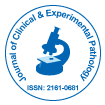Effects on Cancer Diagnosis by Implementation of Pathology Reporting
Received: 10-Jan-2021 / Accepted Date: 24-Jan-2021 / Published Date: 02-Feb-2021 DOI: 10.4172/2161-0681.S9.1000e002
Editorial Note
The ever increasing complexity of cancer treatment requires a high-quality diagnostic process, in which anatomic pathology plays a central role. A complete and clear anatomic pathology report forms the basis for optimal treatment decisions. Depending on cancer type, an increasing number of parameters need to be reported by pathologists.
The way anatomic pathology reports are constructed needs to adapt to the continuous increase in complexity of reported diagnostic data. There is a spectrum in the way pathology results are reported. This spectrum is divided into six levels by Srigley et al. traditionally, a report consists of the following three paragraphs: macroscopy, microscopy and conclusion all completed with free text and without any further guidelines. These traditional Narrative Pathology Reports (NRs) are considered level 1 reporting. NRs are still the standard in most jurisdictions; even though they are prone to misinterpretation and do not always contain all mandatory information. Level three consists of a synoptic-like structured format. With this method, the pathologist follows a checklist per cancer type to ensure that all mandatory parameters are reported. The layout of this type of reporting can still be narrative. More recently, Synoptic Reporting (SR) has been introduced in pathology. With SR, an electronic reporting module is used with standardised reporting language, multiple-choice answering of mandatory pathology parameters and automated generation of the conclusion. Generating a diagnostic report using such a system is much more comparable to filling out a form in an internet browser than it is to narrative reporting using speech recognition software. The result is a well-structured overview of the mandatory parameters for the pathology report. All levels are described in detail by Srigley et al.
The outcome measures evaluated in this systematic review were completeness of the pathology reports and the quality of pathology evaluation. We used two definitions for completeness of pathology reports:overall completeness, the proportion of pathology reports containing all mandatory pathology parameters in a given time frame, and parameter-specific completeness, the proportion of pathology reports in which an individual parameter was present in a given time frame. Both definitions were applied to the selected studies.
Quality of pathology evaluation was defined as the proportion of pathology reports in which the informational content corresponds to established quality indicators, such as lymph node numbers, presence of extramural vascular invasion and resection margins.
In this systematic review, we showed that SR results in more complete pathology reports. Whilst traditional parameters such as ‘tumour type’, ‘grade’, ‘invasion depth’ and ‘nodal status’ are in general well reported with NR, other clinical relevant features such as resection margins and ‘type of local spread (vascular, lymphovascular and perineural invasion)’ are frequently lacking. The introduction of SR results in improved reporting of these parameters. SR also improves the mean number of lymph nodes reported and the proportion of pathology reports with 12 or more lymph nodes. Nature of pathology assessment was characterized as the extent of pathology reports in which the educational substance compares to set up quality pointers, for example, lymph hub numbers, presence of extramural vascular attack and resection edges.
Citation: Yemin W (2021) Effects on Cancer Diagnosis by Implementation of Pathology Reporting. J Clin Exp Pathol S9: e002 DOI: 10.4172/2161-0681.S9.1000e002
Copyright: © 2021 Yemin W, This is an open-access article distributed under the terms of the Creative Commons Attribution License, which permits unrestricted use, distribution, and reproduction in any medium, provided the original author and source are credited.
Share This Article
Recommended Journals
Open Access Journals
Article Tools
Article Usage
- Total views: 1482
- [From(publication date): 0-2021 - Feb 22, 2025]
- Breakdown by view type
- HTML page views: 909
- PDF downloads: 573
